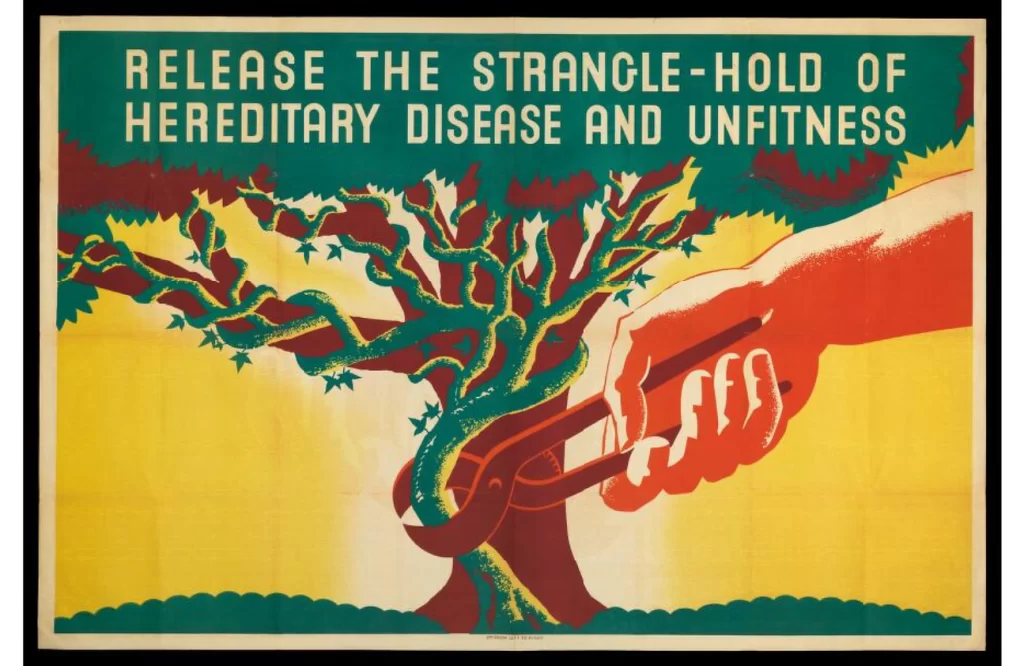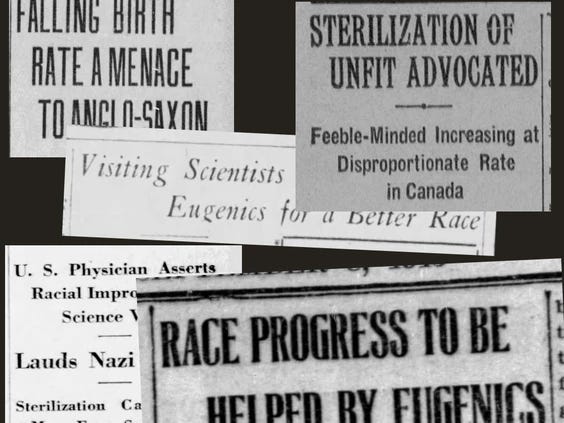The Global Eugenics Movement: National and Fabian Socialism
The history of global eugenics and its potential impact on MAID
This essay will serve as an introduction to concerned citizens on the complexity of corruption within the imperial power structure. For Westerners to understand its multifaceted nature, we must better understand our own history, which sometimes gets obscured to us so that our leaders can manipulate us into interpreting events incorrectly. The power structure does not always lie; sometimes it just encourages us to look at our history through a clouded lens.
I theorized about the core blocks of the structure here, though pieces are missing and the narrative is simplified for clarity’s sake. I have written many essays about the Zionist block, the major ideological inheritor of Nazism embedded within the structure. Zionism is an important piece, but not the sole component of the system that is impacting current global suffering. Many communities focus on one segment or another out of necessity, but this is also causing tension amongst people who are scapegoating each other when they’re unfamiliar with a different area. This essay will serve as one bridge.
I’ve written about how the Nazis engaged in eugenics and unethical organ harvesting practices here, and demonstrated similarities between Israel’s actions as well as possible connections to Canada’s MAID program. However, you can begin to see the complexity of the imperial structure by looking deeper into the history of eugenics. It is not just that Western countries absorbed influence from Nazi Germany after their defeat in WWII, but that Nazi eugenics were also inspired by America in the first place. Nazi eugenics were a part of a broader philosophical movement at the turn of the 20th century, in which many Western countries participated. Despite assertions to the contrary, philosophies from this movement may still be alive today, which I will discuss in regard to MAID below.
Nazi Germany, America, and Canada all participated in this movement. But while Nazi Germany practiced the most memorable policies, they were not the movement’s epicentre. This was America, who was the most advanced in eugenics and the major pioneer of the movement.
Nazi Germany Eugenics: Inspired by California

At the turn of the 20th Century, America was home to the “American Eugenics Triangle,” which was made up of three key locations: 1) the Eugenic Records Office in Cold Spring Harbor, New York 2) the Human Betterment Foundation in Pasadena, California, and 3) John Harvey Kellogg’s Race Betterment Society in Battle Creek, Michigan. While many figures served as philosophical leaders in American eugenics, a major central figure was Charles B. Davenport, who gathered intellectuals into the movement and lobbied the wealth of the E.H. Harriman railroad fortune and the Carnegie and Rockefeller Foundations to bankroll eugenics programs both inside and outside of the USA. It was Rockefeller who funded the Nazi Kaiser Wilhelm Institute for Psychiatry in May 1926, which selected victims deemed as “unfit” to euthanize and harvested their organs for medical research.
Davenport also organized a global eugenics propaganda operation and championed international eugenics meetings. He established a Permanent International Eugenics Commission in the 1920s, which first convened in Brussels. Alfred Ploetz, Erwin Baur, Fritz Lenz, and Eugen Fischer, Nazis who famously pioneered racial hygiene and sterilization policies in Germany, were present at that first meeting, and Ernst Rüdin, architect of Aktion T4, also attended Davenport’s conferences. Aktion was inspired by the Model Sterilization Law, which was championed by the American Harry Laughlin.
Nazi eugenics thus borrowed mostly from the Californian side of the Triangle, where forced sterilization and segregation laws coercively sterilized thousands of Americans. Before WWII, nearly half of coercive sterilizations were completed in California, and though they did not implement gas chambers, it was a commonly suggested method of eugenicide discussed amongst elitists, utopians, and so-called progressives of the era. At the Nazi’s doctors’ trials at Nuremberg, Nazis quoted American eugenic ideology in their defense. Karl Brandt, Hitler’s physician, quoted Madison Grant and Henry Fairfield Osborn’s “Passing of the Great Race” as defense for human experimentation and euthanasia, while Hitler quoted American eugenic ideology in Mein Kampf, stating, “There is today one’s state in which at least weak beginning toward a better conception are noticeable. Of course, it is not our model German Republic, but the United States.”
In 1934, California eugenics leader C.M. Goethe said to a colleague of Germany’s sterilizations: “You will be interested to know that your work has played a powerful part in shaping the opinions of the group of intellectuals who are behind Hitler in this epoch-making program.” Joseph DeJarnette, superintendent of Virginia’s Western State Hospital, stated in the Richmond Times-Dispatch: “The Germans are beating us at our own game,” and Leon Whitney, executive secretary of the American Eugenics Society, said of Nazi eugenics: “While we were pussy footing around, the Germans were calling a spade a spade.” Joseph Mengele, the Nazi Angel of Death, was a former assistant of Otmar Freiherr von Verschuer, a hero in American eugenics circles and a member of the American Eugenics Society.
Eugenics and British Fabian Socialism
Canadians and Brits who have concerns about the Medical Assistance in Dying programs unrolling in our countries may be interested to know that Britain was also involved in the eugenics movement at the turn of the 20th century, through an ideology called Fabian Socialism.
In 1884, the Fabian Society was established in the City of London. It was founded by intellectuals such as Sidney and Beatrice Webb, George Bernard Shaw, and HG Wells, and the core tenets of Fabian Socialism were gradual, reformist socialism, aiming for a classless society through “democratic means” that emphasized state ownership of key industries and social welfare.
Though Nazi “National Socialism” and Fabian Socialism both had the word socialism in their name, they were quite different movements ideologically. Unlike the rapidly moving Nazis, Fabians wanted slow, incremental change via education, policy advocacy, and parliamentary reform. They wanted to avoid violent revolution, and instead preferred “permeating” existing institutions to enact social change. While Nazism was rooted in racial and national supremacy, Fabianism focused on class equality and universal welfare, and while Nazism was nationalist and expansionist, Fabianism was internationalist in outlook, aiming for global socialist cooperation.
What German National Socialism and British Fabian Socialism had in common was that they both unfolded during the same philosophical environment that led to eugenics. They both had anxieties about industrialization, social decay, and the need for “scientific” solutions to societal problems, and both attracted intellectuals, elites, and bureaucrats who wanted to reshape society through centralized planning.
On the surface, British Fabian Socialism was gentler than the German National Socialism. Nazis used forceful “negative eugenics” while Fabians employed “positive eugenics”, but this still involved using organizations, propaganda, and elite bureaucrats to “persuade” people into “choosing” the eugenics they promoted. Both were interested in methods that were top-down, and both were literally participating in eugenics.
I’ve used air quotes to mention how Fabians favoured “democratic” means because the ideology had elitist assumptions and the average person’s ability to influence policy was negligible. Like the Nazis, the Fabians saw the state as a legitimate tool for shaping populations, and they made assumptions about human worth and who could decide what worth was. While Fabian eugenics were less about race and more about class and health, Fabian philosophies still reflected assumptions about who was “fit” to reproduce and survive, and it was the elites and bureaucrats who could use hierarchical tools at their disposal to promote their desired policies, thus marginalizing grassroots and working-class agency.
Sidney and Beatrice Webb for instance believed that the “parasitic” “residuum” had hereditary defects, and would increasingly degenerate. Their 1909 Minority Report on the Poor Law advocated for segregating those with intellectual disabilities, and their 1913 book The Decline in the Birth-Rate argued for encouraging “superior” classes to reproduce. As well, the British Mental Deficiency Act of 1913 assumed “experts” like doctors and administrators could determine who was unfit for society and could be institutionalized, but this led to abuse, where “experts” would institutionalize people based on class or social nonconformity rather than evidence of medical concerns. George Bernard Shaw suggested “lethal chambers” for the “socially useless,” assuming that intellectuals and bureaucrats were the ones who could decide who was useless. Shaw was a Nobel Prize winner, demonstrating how prestigious elites of the era were not necessarily benevolent, including those lauded as WWII “heroes.”
The Fabian Society significantly shaped Britain’s Labour government, which is the current ruling party and may still hold Fabian assumptions about state-led social engineering that trumps individual rights and input. For obvious reasons, after the Holocaust, it became less socially permissible for the Fabians to openly promote eugenics, however, while they began to denounce it and shifted their focus, their elitist legacy continued. UK Prime Minister Keir Starmer and Mayor of London Sadiq Khan identify as Fabians, and it can certainly be argued that Starmer’s leadership reflects Fabian gradualism, prioritization of bureaucratic control, and establishment interests over grassroots and individual concerns.
Starmer’s government for instance ended winter fuel payment for approximately 10 million pensioners around July 2024, which aimed to address a fiscal deficit. There was minimal public or parliamentary consultation and it was justified as an economic necessity. However, this obviously affected those pensioners who relied on the payment. Starmer’s government also implemented an early release scheme of prisoners in September 2024, which created controversy as it was rolled out with little public or victim consultation. Also, since this essay is a bridge, you’ll note that Starmer is also a Zionist.
Medical Assistance in Dying’s Link to Fabian Socialism
As aforementioned, the eugenics movement was global. The British socialist intellectual environment impacted newly “independent” British colonies, and this is why Fabian societies were also in Commonwealth countries like Canada. Canada’s was called the Douglas-Coldwell Foundation, preceded by the League for Social Reconstruction. This thinktank shaped the Co-operative Commonwealth Federation and early New Democratic Party policies. You can also read more about how American and Nazi eugenicists influenced Canada here.
I am arguing that Canada’s Medical Assistance in Dying program incorporates the “positive eugenics” and ideologies of Fabian Socialism. This does not negate what I have argued in this essay. Both may be true, and this is what I mean about the complexity of the power structure. The Canadian Liberal government’s philosophies may borrow from Fabian Socialism while a lack of action on illegal organ trafficking simultaneously benefits Canadian elites, the government’s Zionazi allies in Israel, and therefore Canada’s Zionist allies in America and Europe. As well, the Canadian government may also be generally influenced by Ukrainian Nazism which you can read about here and here.
Regarding the Fabian Socialist influence, Canada’s MAID program, while claiming to be rooted in individual autonomy, incorporates the Fabian Socialist strategy of “persuasion” as a tool to promote eugenics. The step-by-step removal of barriers for MAID is comparable to Fabian gradualism, and as I discussed in my article, MAID was reportedly voted for “democratically,” however only certain people and “experts” were consulted. I did not get to vote for example. And this is similar to what happened with Canadian eugenics in the 20th century: the most vocal supporters were doctors.
My interpretation of MAID is that it is normalizing euthanasia as a solution for broader societal issues like poverty and disability, Fabian-style. As I’ve discussed, it is actually impossible to prove that a person really chose MAID due to a health issue and not a mental health issue or social concern, as people with chronic health issues often also feel depressed or like they are a burden to their caregivers. Many seeking MAID could manage both their health and mental health with better supports, however while the Canadian Liberal government promised to provide more palliative supports if MAID was introduced, they did not. The government for example will provide resources for MAID but not for palliative care in rural areas. On Saltspring Island for instance there are a number of GPs who have MAID training but no one has a year of training to be a palliative care consultant, which means the whole community doesn’t have palliative supports. The government will also fly MAID assessors to rural areas for euthanasia, but won’t pay to fly up palliative care.
If they did, it would certainly reduce the number of people who felt MAID was their best or only option. But it’s more expensive, and a Fabian eugenicist might provide a fiscal efficiency argument, as the Nazis also would. Fabians prioritized systemic efficiency, and justified eugenics because it reduces what Fabians would call wasteful resource use for “useless eaters,” a term associated with not only Nazis but eugenicists of this era in general. This cost savings report indicates that the net savings from MAID’s Bill C-7 adds up to $149 million. As well, as I’ve mentioned, Canadian hospitals are overwhelmed, with Canada’s hospital bed density lagging behind OECD averages (2.5 per 1000 people). A Fabian eugenicist would argue that MAID maximizes state efficiency because it not only saves the state money but also frees up beds for less useless eaters. The end thus justifies the means.
The issue though is that it is not the bureaucrats that pay the price for this end. It is vulnerable people. And as MAID is essentially a state-sponsored program that employs manipulative promotional rhetoric in state and oligarch-funded media, people may be psychologically “persuaded,” Fabian-style, into a “choice” that was actually actively encouraged by the state. MAID is thus an example of how elites and bureaucrats can utilize state tools to maximize state efficiency over individual rights. You know, similar to the genocide in Gaza and the proxy war in Ukraine, where they also ignore our voices and insist on death.






Truly excellent and important writing.
Really frightening. Seriously disturbing. It figures. More and more these days it seems clear that our various governments hate us and want large numbers of us to die, the sooner the better. Canada’s MAID program is a small part of a larger initiative to kill billions of “useless eaters” on a dying planet that is running out of resources.